NOTE: I find the flatfold is the perfect finishing technique for those stitching projects that you don't necessarily want to frame, yet the stitching demands something of "importance". This is the perfect way to display those Seasonal Stitches that are only displayed "seasonally", during a special time of the year, or if your decorating tastes make you "switch it up" from time to time. They are easily made and fold down for easy storage.
How to store a flatfold: If the flatfold has been on display, take a natural bristle brush (i.e. I use a makeup "powder brush") and gently brush the flatfold face free of dust. Brush the back, sides and especially the top "bind" part to free all dust. Then, fold it down - if made the way I make mine (steps below) - pull the "fabric tongue" out so that the back piece is flat against the top face. Wrap in tissue paper, and lay flat in a plastic tote. During its next cycle of display it will emerge from the tote as perfect as the day you made it!
To finish a stitching project into a flatfold the way I do it, you will need:
1. Acid Free Mat Board
2. A Mack Knife or Cutting Knife of some kind
3. White Craft Glue (i.e. Aleene's Tacky Glue) available at most general stores and craft stores
4. Clear drying Craft Glue Spray (i.e. Aleene's Tacky Spray)
5. Cotton Batting
*I have finished personally and professionally for many years now and I find this to be superior to nylon fiber blend battings - it creates a more flat, perfect finish. It's a little more expensive, but worth the cost in the end.
6. Scissors/Rotary Cutter
7. Cutting Self Healing Mat
8. Large Quadrant Ruler
9. Stitched piece
10. Complimentary material (1/4 - 1/2 yard will be sufficient depending on size)
11. Pre-made cording OR 3-4 skeins of DMC that the piece is stitched with or compliments the stitching in color to make the cording.
*When using cording, I typically make my own cording at all times on all my projects, however for this project, I used pre-made purchased cording - found in local craft and material stores such as Joann's or Hobby Lobby.
Step 1:
a.) Gather your supplies and have them handy for use in a well lit work area.
b.) Measure your stitched piece and play around with the dimensions you would like to use for the piece. This stitched piece measured around 7 1/4 inches square. Once you decide on the size, cut FOUR pieces of mat board to that specified dimension.
*Line them up and make sure they are square. Take your time in determining this. In my opinion, there is nothing more detracting from a piece than to have sloppily sized, irregularly shaped pieces and it is quite noticeable at completion. Like the old adage, measure twice, cut once....take the time now so that at the end it is perfect.
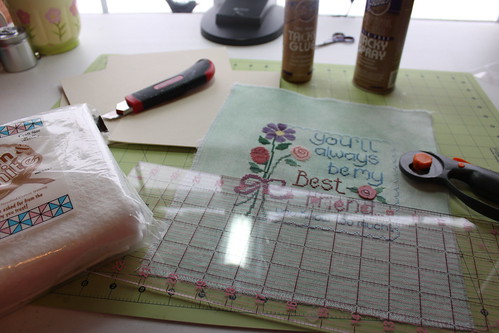
STEP 2:
a.) Take TWO of the squares (these will eventually be your front "face board" and behind "back board"), and lightly spray them with the Craft Glue Spray.
HINT: In my craft room I use a large box that I lay a piece of heavy cardboard over the top like a table top. When I spray, any over-spray goes into the box and not on my carpet.
b.) After spraying, place the glue side down onto the cotton batting and cut the batting to the edges as shown below.
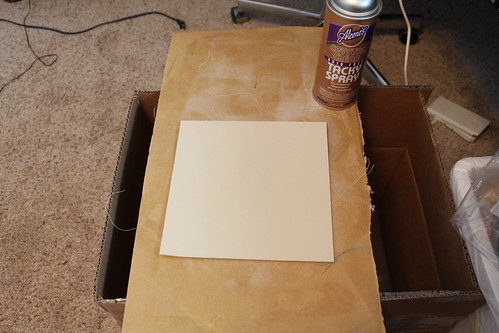
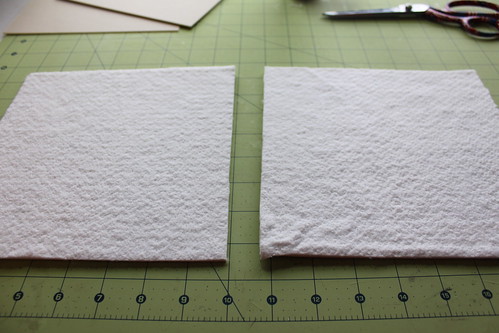
STEP 3:
a.) Mount the stitched piece onto one of the cotton batting covered board.
HINT: hold it up to the light when centering this helps to get it aligned perfectly
b.) Using White Craft Glue glue the edges of the centered stitching onto the back of the mat board.
HINT: Sticky glue fingers? No problem, I always keep a small plastic bucket (like an old gallon ice cream bucket) half filled with warm water and a hand towel right by my work area. If I get a bit of glue on my fingers I rinse and dry immediately without having to leave the room. When you are done working, dump and rinse the bucket and it will be ready for the next time!
c.) When completely mounted and glued down, set aside to dry as you work on the other components of the flatfold.

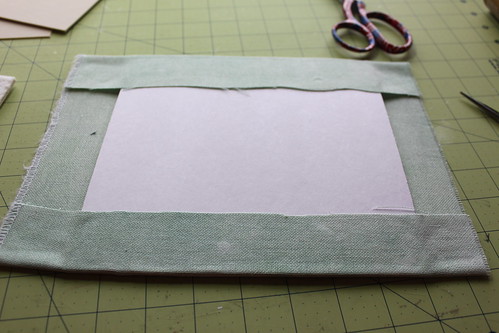
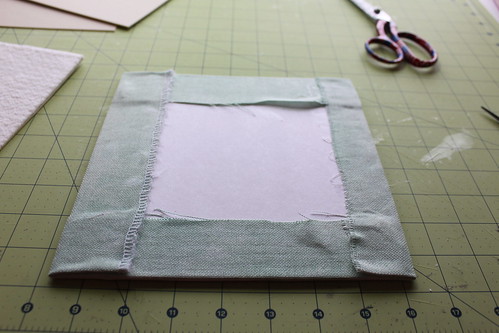
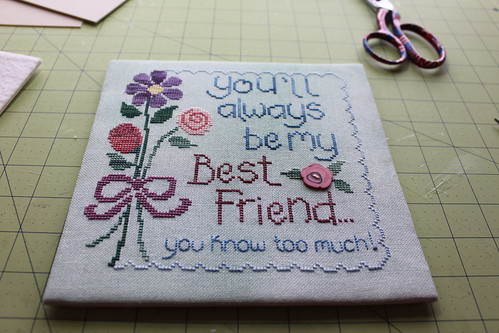
STEP 4:
a.) Cut out two pieces of complimenting fabric to the size of the square adding about 1- 2 inches per side so that the edges may be mounted to the back of the square. Then, spray the TWO pieces of mat board (WITH OUT BATTING!) with Craft Glue Spray.
b.) Lay the glue side flat down onto the cut pieces of complimentary fabric
c.) Glue the edges of the fabric to the back just as we did with the stitched part above.
d.) At the end of this step you will have TWO no batting, mat board pieces covered in the complimenting fabric.


STEP 5:
a.) Take the last remaining square (which will have cotton batting glued to the front) and cut a piece of the complimenting fabric to size with 1-2 inches of extra fabric on the bottom and sides but at least 3-4 inches at the top.
b.) Glue the bottom of the material to the back with the white craft glue and then on both sides run a line of glue up the sides all the way to the top of the material. Gently fold over, on both sides. When done your "back face" piece should look similar to the picture below.
c.) Sit it aside to dry a bit while you work on the other parts.
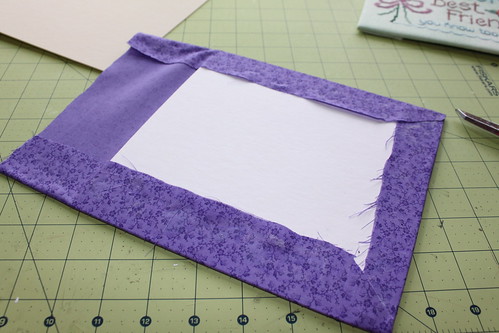
STEP 6:
a.) cut a piece of the complimenting fabric about 7 inches long and about 5 inches wide (now this is rough dimensions - all you have to do is cut a piece of fabric longer than it is wide)
b.) spray it lightly on the WRONG SIDE (of the fabric) with Spray Glue (follow along visually with the steps below)
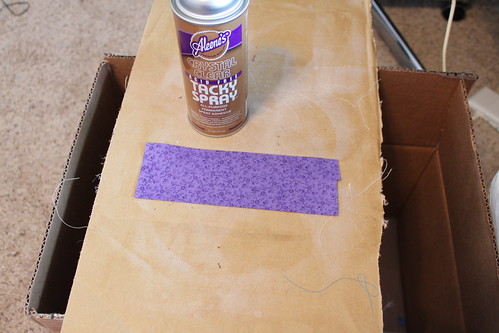
c.) fold over one side 1/4 of width:
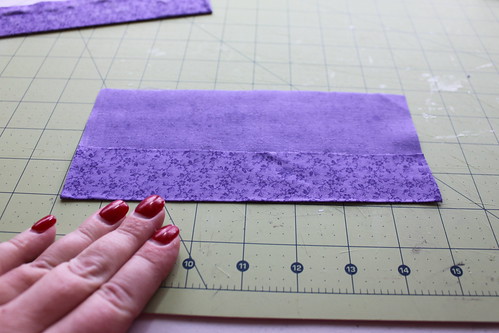
d.) fold over the other side with the edges meeting in the middle - then spray this side (as shown) lightly with spray glue.

e.) fold in half with edges meeting - finger press flat.
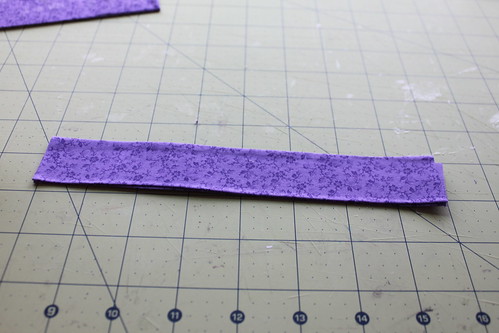
ASSEMBLY:
At this point you have all the components made to start assembling your flatfold. You should have:
1. ONE piece with the stitching mounted onto it
2. TWO pieces with complimentary fabric mounted onto it
3. ONE piece with three sides mounted and about 3-4 inches of fabric hanging off the top
4. ONE fabric tongue
(pieces pictured here)
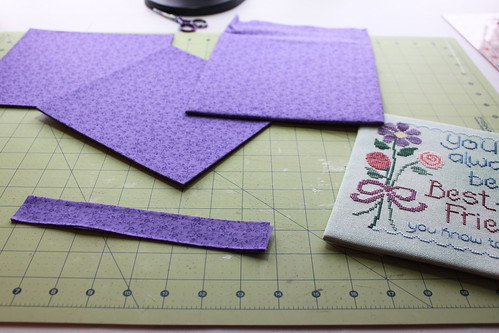
STEP ONE:
a.) Take the "back face" board and at the top where the extra fabric is located, spray the glue spray lightly along the edge right along the top edge where my thumb is located (from corner to corner)
*This is VERY important for a later step and you will understand why at that time. But for just this time, spray the top edge of the board at the extra material line and then continue on with the step below.
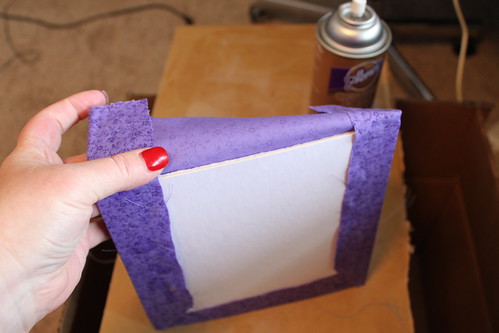
STEP 2:
a.) Take the "back face" board (the one with the extra piece of fabric at the top) and place it flat on your work surface with the extra fabric at the top.
b.) center and glue with white craft glue ONE END of the fabric tongue to the bottom of the "back face" board (again this is the one with the extra fabric at the top)
c.) now take ONE of the boards that is mounted with the fabric only, liberally run glue lines on this piece as well as the bottom piece (I say liberally, but you don't have to go crazy AND you don't have to touch it to smooth the glue)
d.) sandwich the bottom "backing face" and the material mounted board together WITH THE EXTRA FABRIC LEFT OUT
*follow photos for visual reference - last photo shows what you should end up with at the end of this step
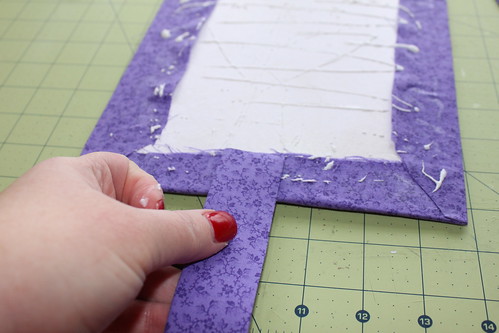
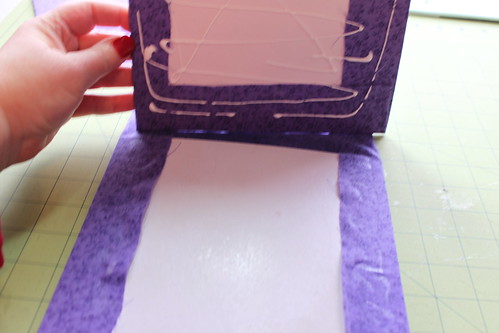
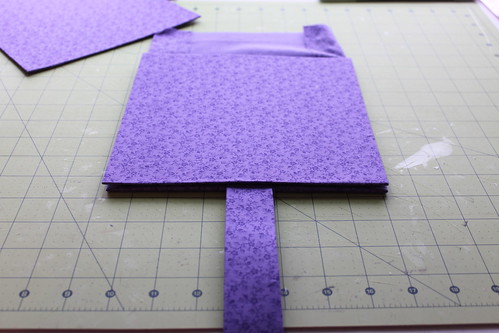
STEP 3:
a.) lay on top of the shape from above the last remaing piece of fabric mounted board (right sides together) align it to the bottom piece, so that stack is perfect aligned.
b.) Liberally run lines of glue at the top 1-2 inches of board as shown:
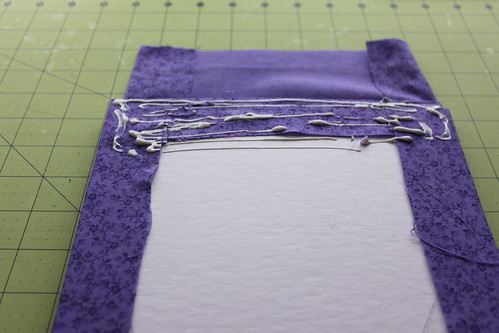
c.) fold over the extra piece of fabric and with much force, pull and stretch this fabric to make a tight bond at the top.
HINT: This is where the spray glue at step 1 above comes into play...that bit of spray glue will help adhere the material that will span the "sandwich" that we are making from the very bottom "back face" piece to this third layer in the sandwich. If this step is not performed in this manner, the flatfold pieces will not be sturdy and the front part will be wobbly and slip up when it is in display position. Think of it in this way - we've all had books that are bound, when they've reached a certain age, the binding is lost and a group of papers fall out. That is exactly what will happen if this step is not performed in the way described - with firm, pulling and gluing firmly down of the extra spanning fabric piece.
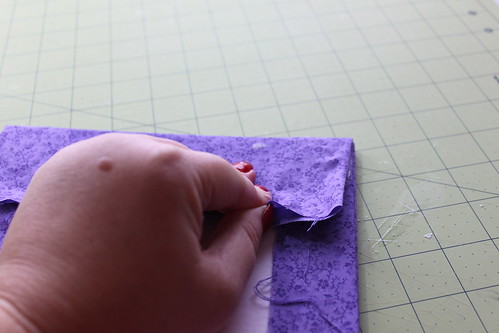
d.) Upon completion you will have a smooth, flat, tight, perfect edge top edge to your flatfold
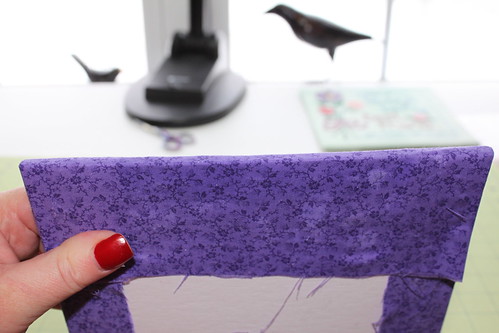
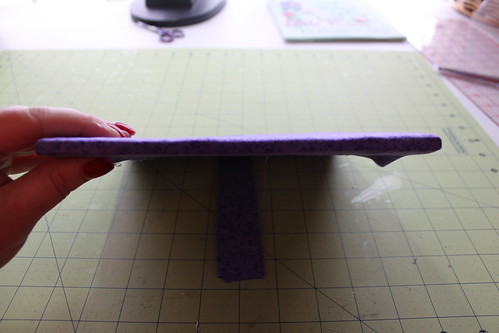
STEP 4:
a.) Take the fabric tongue and center and glue it with white craft glue to the last material mounted square.
HINT: you only need about 2 - 3 inches span from back part of the face board to front part of the flatfold. So glue your fabric tongue keeping this length in consideration....you don't want a large gaping flatfold span, just a short one.
b.) then liberally run lines of white craft glue all over the material mounted board and mount the stitched piece on top of it.
HINT: At this time make sure - that all parts of the "sandwich" are perfectly aligned and "square", that there is no glue seeping out from any of the seams, that all edges are in contact. Take care of any glue seeping out, alignment issues now and move on to the next step.
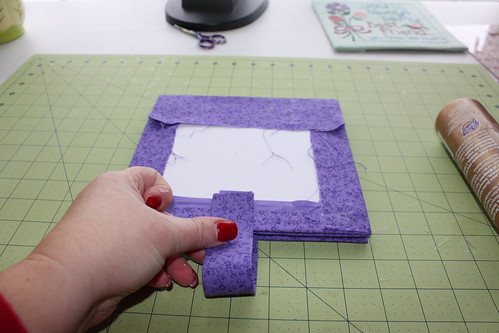
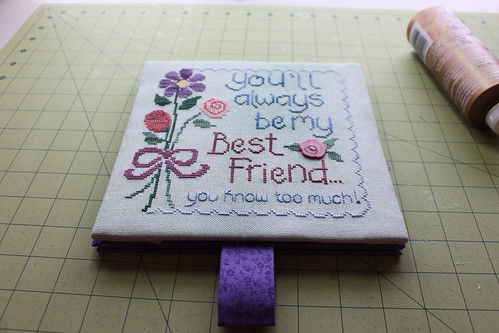
STEP 5:
put the entire flatfold into a large ziplock back OR put plastic wrap loosely around it to protect it, then place it under your weighted pressing board/object of choice.
NOTE: Please see my "Special Shaped Ornament" tutorial for my weighted pressing object of choice (i.e. I use a milk crate filled with old magazines) The key is to have evenly distributed weight over the entire flatfold.
After 30 - 60 minutes your flatfold will emerge looking like this:
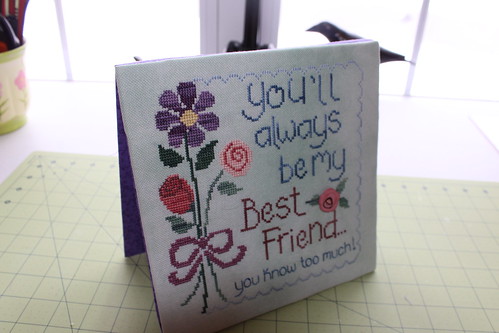
STEP 6:
Add a light line of white craft glue along the edge (one side at a time) until the cording meets at the top left hand corner. Allow the cording to dry a bit, then make a simple knot, cut the lengths and tie the ends off and your project is complete. You will have a perfect flatfold each and every time!
NOTE: You may also edge the flatfold face with ribbons, braiding, etc., add decorative pins or beads, add little "feet" for the flatfold to "stand" on and top it with frilly bows etc. The choice is limitless to primping the flatfold.
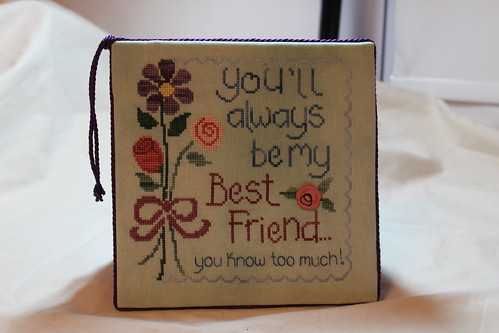
Stitching courtesy of Judith F.
